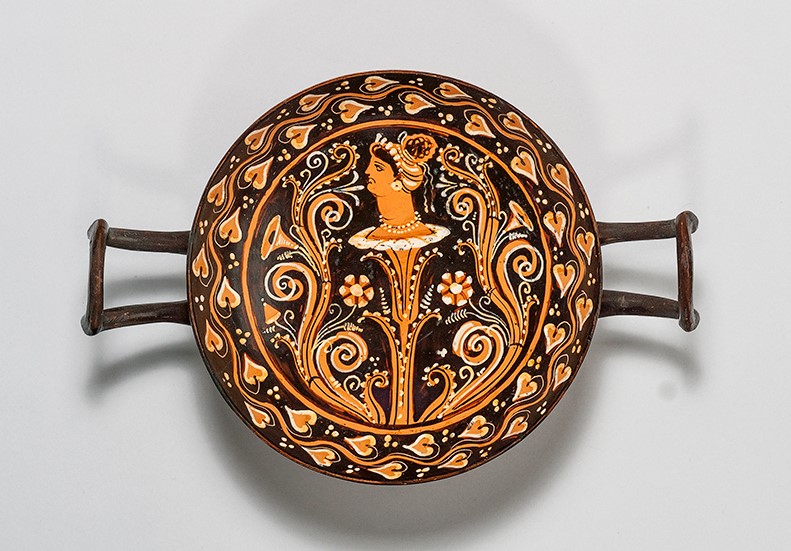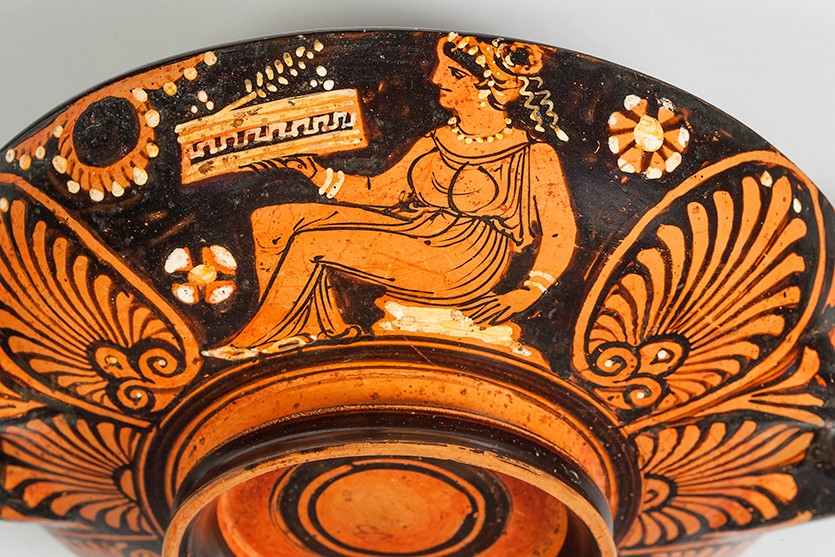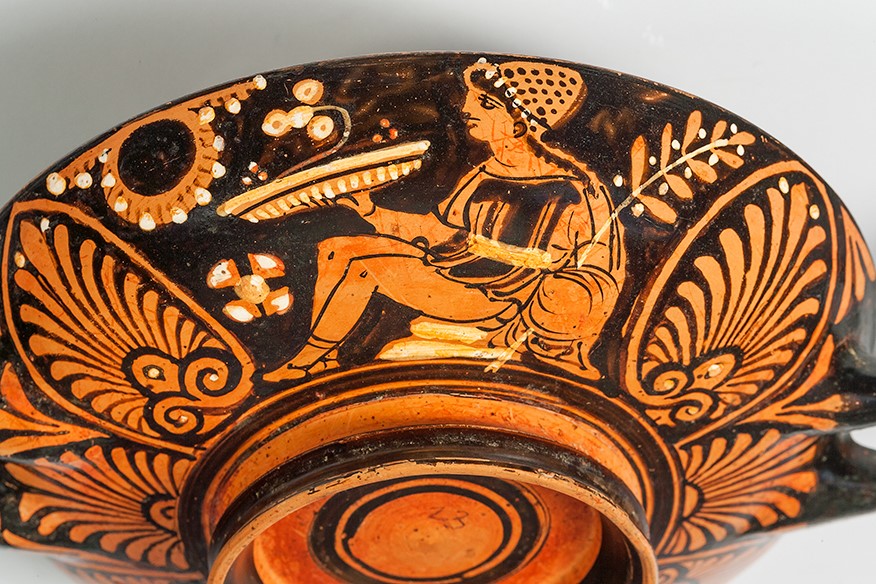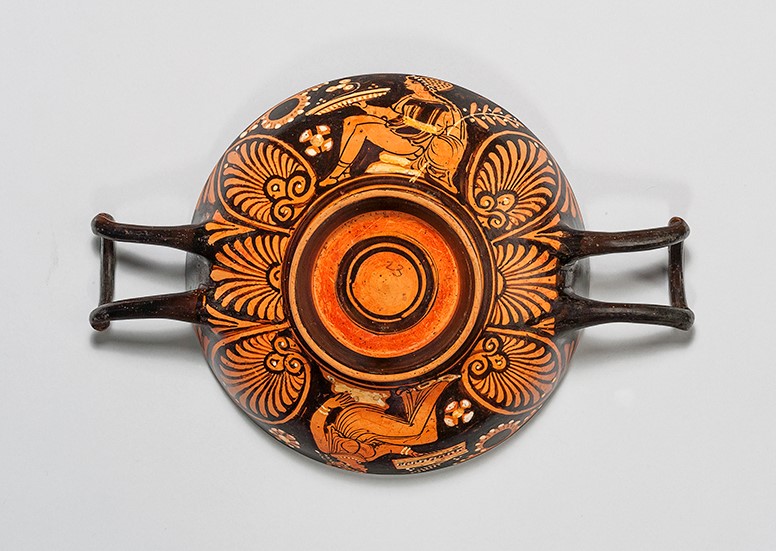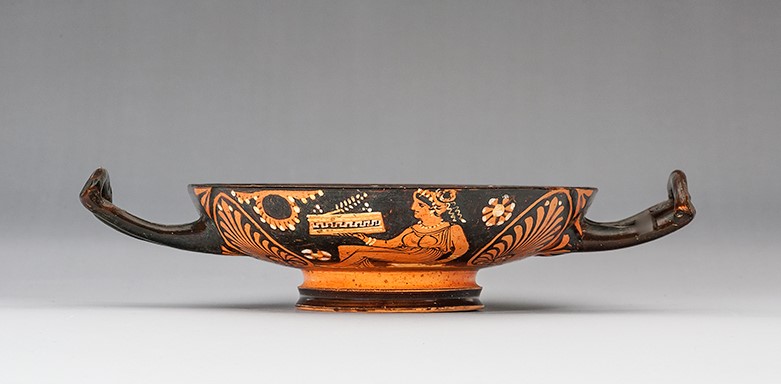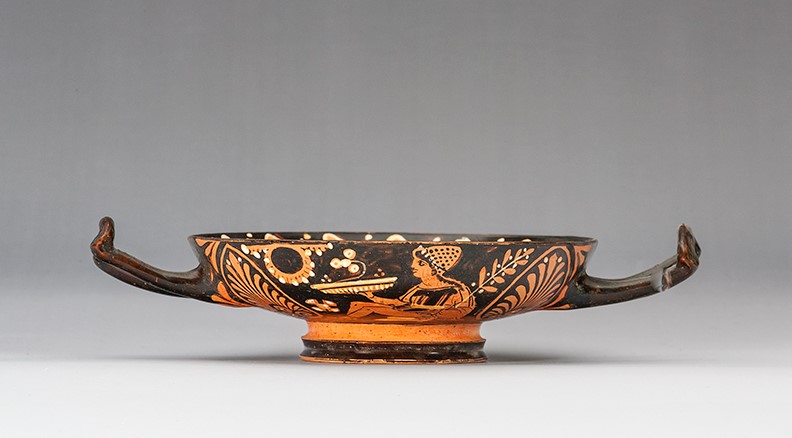Acquisition number: 1965.23
Stemless Cup.
The foot is in two degrees, the stem reserved, the lower member black. The resting surface is reserved, the inner face of the foot black. The underside is reserved, strongly reddened and decorated with concentric circles.
Inside: A female head, left, rising from a calyx amid elaborate floral work, the whole within an ivy border. Abundant use of added white and yellow for details.
A: A woman seated left on a rock and holding a basket in her right hand; in the field are a wreath and two rosettes.
B: A warrior seated left on a rock with a dish in his right hand and a branch in the crook of his left arm. He wears native dress with black-striped tunic and conical hat. In the field are a wreath and a rosette, in the same positions as their equivalents on side A.
There are palmette designs about the handles.
Title: Stemless Cup - 1965.23
Acquisition number: 1965.23
Attribution: Close to the style of the Menzies Painter.
Author or editor: J.R. Green
Culture or period: West Greek.
Date: c. 340 - 320 BC.
Material: Clay - Terracotta
Object type: Pottery - Red-figure
Dimensions: 156mm (w) × 48mm (h)
Origin region or location: Italy
Origin city: Altamura.
Display case or on loan: 8
Keywords: Apulian, Red Figure, Apulian Tomb Group, Menzies Painter, Messapian
A.D. Trendall, Gli indigeni nella pittura italiota (Taranto 1971) fig. 43 (side B); J.R. Green with B. Rawson, Catalogue of Antiquities in the Australian National University, A.N.U. (Canberra, 1981) 54-55; A.D. Trendall and A. Cambitoglou, The Red-Figured Vases of Apulia, ii (Oxford 1982) 828 no. 112, pl. 313, 3-4.
1965.23
Stemless Cup
Ht 4.8cm; diam. 15.6cm.
The foot is in two degrees, the stem reserved, the lower member black. The resting surface is reserved, the inner face of the foot black. The underside is reserved, strongly reddened and decorated with concentric circles.
Inside: A female head, left, rising from a calyx amid elaborate floral work, the whole within an ivy border. Abundant use of added white and yellow for details.
A: A woman seated left on a rock and holding a basket in her right hand; in the field are a wreath and two rosettes.
B: A warrior seated left on a rock with a dish in his right hand and a branch in the crook of his left arm. He wears native dress with black-striped tunic and conical hat. In the field are a wreath and a rosette, in the same positions as their equivalents on side A.
There are palmette designs about the handles.
The stemless is the standard form of cup in Apulia in fourth-century red-figure. Female heads amid floral motifs like that decorating the inside of this cup became increasingly common from the second quarter of the century. For discussion of the motif, see for instance K. Schauenburg, “Zur Symbolik unteritalischer Rankenmotive”, Mitteilungen des Deutschen Archäologischen Instituts, Römische Abteilung 64, 1957, 198-221, and M.W. Stoop, Floral Figurines from South Italy (Assen 1960) 55ff.
Representations of native Italians in Apulian red-figure are normally of males (in Apulian, though not Campanian, the accompanying females tend to be shown as wearing dress of Greek style, as the woman on side A here) and they are usually shown as warriors. They are most often depicted on vases that seem to have been created for trade with the native peoples, particularly column-kraters and, in the earlier phases, nestorides.
These young men typically have long hair drawn back from the face, a short, short-sleeved, highly decorated tunic with seams running up the arms to the shoulder; they wear an ornamented metal belt which seems to have been something of a status symbol (examples are preserved); and they normally have a cap of the kind Greeks called a pilos with a rough finish implying wool or fur. They also seem to have worn fairly tall boots.
The setting here and on a number of other examples would seem to be a sanctuary and the occasion one of celebration: the young man carries a branch over his left arm and a phiale in his right hand; a wreath hangs in the background on the upper left.
How we should interpret these scenes in general is not entirely clear. It is arguable that Tarentine vase-painters depicted native males as young warriors because this was how they thought of them from a limited range of encounters. On the other hand their creation may have been more sophisticated in the sense that the painters envisaged a particular use, perhaps as funerary vessels for the native context. At the same time we may observe that the sanctuary setting is expressed in Greek terms and the women depicted in these scenes wear thoroughly Greek dress. Some scholars have seen this as evidence of strong hellenisation among the native peoples, but it is curious if the women were more strongly hellenised than the males (who would have been more likely to have direct contact with ethnic Greeks). It is perhaps more realistic to recognise that Tarentine vase-painters were not photographers but were creating images from within their own repertoire, even if with an eye to the native market. Note also the typically Tarentine decoration of the inside of the cup. (And one remembers how much Australian 19th-century painting was constructed in terms of European styles of depiction.) Nor should we suppose that they were rigorously consistent.
For a good brief discussion and summary, see, in addition to A.D. Trendall, Gli indigeni nella pittura italiota (Taranto 1971), M. Castoldi, “II riposo del guerriero. Riflessioni sulle raffigurazioni di giovani indigeni nella ceramografia apula”, in: E. Herring et al. (eds), Across Frontiers: Etruscans, Greeks, Phoenicians and Cypriots. Studies in Honour of David Ridgway and Francesca R. Serra Ridgway (London 2006) 147-155, with colour illustrations of the same vases in G. Sena Chiesa and E.A. Arslan (eds), Miti greci. Archeologia e pittura dalla Magna Grecia al collezionismo (Milan 2004) 203-204. She also makes some brief comments in “Guerrieri e signori dell’antica Apulia attraverso i vasi della Collezione Intesa Sanpaolo”, in: G. Sena Chiesa (ed.), Vasi, immagini, collezionismo (Milan 2008) 249-265. On the armour, see A.-M. Adam, “Le bûcher de Patrocle et l’ostentation des armes dans les sociétés indigènes d’Italie méridionale”, Ktema 25, 2000, 123-132. On the belts worn by the warriors, M. Suano, “Il cinturone sabellico-sannita come abbigliamento sociale”, in: Studi sull’Italia dei Sanniti (Milan - Rome 2000) 183-191, and for examples of the actual belts, ead., Sabellian-Samnite Belts in the British Museum (London 1986). On the depiction of the women, M. Dewailly, “Les femmes de guerriers indigènes dans les scènes de libation représentées sur les vases à figures rouges d'Ialie du Sud au IVe siècle”, Melanges d’Archéologie et d'Histoire - Antiquité 94, 1982, 581-623, and her “Acculturation et habillement en Grande-Grèce”, in: Modes de contacts et processus de transformation dans les sociétés anciennes. Actes du Colloque de Cortone (24-30 mai 1981) (Collection de l’Ecole française de Rome 67, Rome 1983) 257-272 (a volume with much relevant discussion). Also H. Frielinghaus, Einheimische in der apulischen Vasenmalerei.Ikonographie im Spannungsfeld zwischen Produzenten und Rezipienten (Berlin 1995). By way of background, see for example M. Torelli, “Greci e indigeni in Magna Grecia: ideologia religiosa e rapporti di classe”, Studi Storici 18, 1977, 45-61; M. Tagliente (ed.), Italici in Magna Grecia: lingua, insediamenti e strutture. Atti del convegno di Acquasparta, 30-31 maggio 1986 (Venosa 1990).
The style of painting is related to that of the Menzies Painter but is in some ways closer to that of the Armidale and Bristol Groups among the associates of the Patera and Ganymede Painters. Trendall pointed out that another stemless, in the Sette Cirillo collection in Bari, is a near-replica.
A.D. Trendall, Gli indigeni nella pittura italiota (Taranto 1971) fig. 43 (side B); J.R. Green with B. Rawson, Catalogue of Antiquities in the Australian National University, A.N.U. (Canberra, 1981) 54-55; A.D. Trendall and A. Cambitoglou, The Red-Figured Vases of Apulia, ii (Oxford 1982) 828 no. 112, pl. 313, 3-4.
Australian National University.
